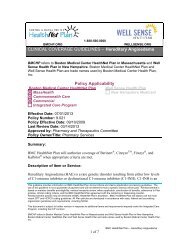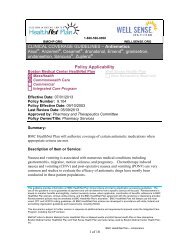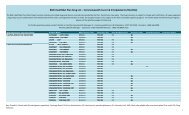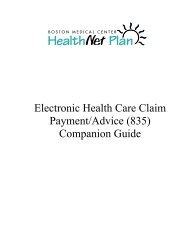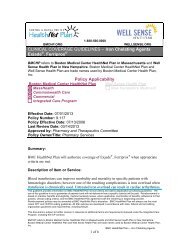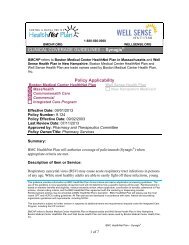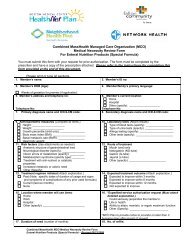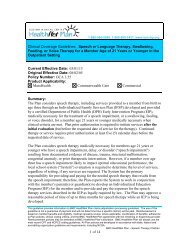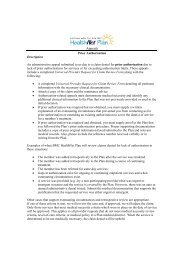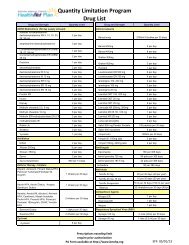IVIG - BMC HealthNet Plan
IVIG - BMC HealthNet Plan
IVIG - BMC HealthNet Plan
You also want an ePaper? Increase the reach of your titles
YUMPU automatically turns print PDFs into web optimized ePapers that Google loves.
do not require treatment with <strong>IVIG</strong>, high-dose corticosteroids or any other specific<br />
therapy. 17 Splenectomy should be considered in children with symptomatic, severe<br />
thrombocytopenia for at least one year. 13-14 In Rh-positive children who relapse after<br />
initial therapy, Rh0 [D] immune globulin is preferred, if it is effective, over <strong>IVIG</strong>. Longterm<br />
corticosteroids are usually unacceptable in children due to adverse effects and<br />
responses are not durable. Only 5% of children with ITP still have thrombocytopenia that<br />
requires therapy after one year.<br />
B-cell chronic lymphocytic leukemia (CLL) for prevention of bacterial infections in<br />
patients with hypogammaglobulinemia and/or recurrent bacterial infections. 5 In one<br />
placebo-controlled study, <strong>IVIG</strong> significantly reduced bacterial infections and the median<br />
time to first bacterial infection for the <strong>IVIG</strong> patients was greater than 365 days vs. 192<br />
days with placebo. The number of viral and fungal infections was not different between<br />
the two groups.<br />
Kawasaki disease for the prevention of coronary artery aneurysm. 5 Efficacy of <strong>IVIG</strong> in<br />
conjunction with aspirin given in the acute phase of Kawasaki disease in reducing the<br />
prevalence of coronary artery abnormalities is well-established. 18<br />
Chronic inflammatory demyelinating polyneuropathy (CIDP) to improve<br />
neuromuscular disability and impairment and for maintenance therapy to prevent<br />
relapse. 6,19 Efficacy of <strong>IVIG</strong> was established in a multi-center, double-blind trial using<br />
immune globulin intravenous caprylate/chromatography purified (Gamunex). Patients<br />
with CIDP were randomized to <strong>IVIG</strong> or placebo given as a loading dose at baseline over<br />
2 to 4 consecutive days and then a maintenance dose every 3 weeks for up to 24 weeks.<br />
Patients who did not improve and maintain this improvement for 24 weeks were crossed<br />
over to the alternate study drug (rescue). Significantly more patients responded to <strong>IVIG</strong><br />
47.5% vs. 22.4% with placebo (25% difference; 95% confidence interval [CI] 7% - 43%;<br />
P = 0.006). This study included patients who were <strong>IVIG</strong> naïve and subjects who had<br />
previously received <strong>IVIG</strong>. See table 1. In an extension phase, time to relapse was<br />
evaluated in the subset of patients who previously responded to <strong>IVIG</strong>, i.e., patients who<br />
completed the efficacy phase or rescue phase for 24 weeks; 31 were randomly reassigned<br />
to continue with <strong>IVIG</strong> and 26 were reassigned to placebo (withdrawal period) for 24<br />
weeks. Subjects who continued on <strong>IVIG</strong> had a significantly longer time to relapse vs.<br />
patient on placebo (P = 0.011). The probability of relapse was 13% with <strong>IVIG</strong> vs. 45%<br />
with placebo (hazard ratio, 0.19 [95% CI, 0.05, 0.70]).<br />
Table 1. Outcomes in Intent-to-Treat Population Efficacy Period (24 weeks). 6<br />
<strong>IVIG</strong><br />
Placebo<br />
Efficacy Period Responder* Non- Responder* Non- P-<br />
Responder<br />
Responder Value**<br />
All subjects 28/59 (47.5%) 31/59 (52.5%) 13/58 (22.4%) 45/58 (77.6%) 0.006<br />
<strong>IVIG</strong> naïve 17/39 (43/6%) 22/39 (56.4%) 13/46 (28.3%) 33/46 (71.7%) 0.174<br />
This guideline provides information on <strong>BMC</strong> <strong>HealthNet</strong> <strong>Plan</strong> claims adjudication processing guidelines. The use of this<br />
guideline is not a guarantee of payment and will not determine how a specific claim(s) will be paid. Reimbursement is<br />
based on member benefits and eligibility, medical necessity review, where applicable, coordination of benefits, adherence<br />
to <strong>Plan</strong> policies, clinical coding criteria, and the <strong>BMC</strong> <strong>HealthNet</strong> <strong>Plan</strong> agreement with the rendering or dispensing provider.<br />
Reimbursement policies may be amended at <strong>BMC</strong> <strong>HealthNet</strong> <strong>Plan</strong>’s discretion. <strong>BMC</strong> <strong>HealthNet</strong> <strong>Plan</strong> will always use the<br />
most recent CPT and HCPCS coding guidelines.<br />
<strong>BMC</strong> <strong>HealthNet</strong> <strong>Plan</strong> – <strong>IVIG</strong><br />
4 of 45






